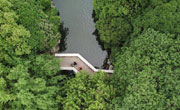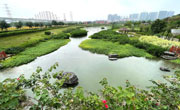"Slow trains" bring "acceleration" of development
"Slow trains" refer to the green trains that did not raise their speed during China’s great railway speedup. Most green trains are operating in the remote mountain regions where highway traffic is inconvenient. Every day, one or two pairs of trains are dispatched according to daily schedule, with low ticket pricing that have remained unchanged throughout the decades. These trains are mostly meant for public welfare and poverty alleviation.
Railways, highways, and other basic infrastructures bring flows of people, materials, and information from rural areas into cities, into domestic and international markets. In turn, this realizes the efficient allocation of rural productive factors, which is a necessary path to industrialization and urbanization for rural areas. The public-welfare nature and low charges of "slow trains" provide a huge travel convenience for residents in remote mountain regions. Compared with highway transportation, "slow trains" can provide a larger quantity of supplies, which makes it possible for people to trade with residents from others regions. "Slow trains" also create the opportunity for rural children to attend schools outside their local regions, help farmers bring self-produced farm goods to trade at more distant places, allow villagers to seek medical care in hospitals at their county seats, create the opportunity for villagers from different villages to communicate with each other, promote exchange of production techniques and experiences, and elevate the standards of cultural life.
Currently, our nation has succeeded in achieving our goal of poverty alleviation. Many villages entered the new period of implementing the rural revitalization strategy. At this new starting point, "slow trains" can bring "acceleration" and inject strong stimulation into rural revitalization.
"Slow trains" have low management and maintenance cost. Compared with highway transportation, it is more suitable to rural residents’ purchasing power and willingness to consume. In some remote mountain regions, the natural environments are harsh, highway transportation is susceptible to climate and terrain. Railway transportation can solve the transportation problems caused by harsh natural environments and climate changes, which is a "quality vehicle" trusted by rural people.
"Slow trains" connect many mountain villages, and provide people with a mobile "central settlement point": children can study in the carriage, and farmers can trade their goods in the "mobile market". The unique culture of "slow trains" and the scenery along the railway lines have tremendous attractions to people who are long-term city residents. City people can enjoy the beauty of slow life on the "slow trains", feel the freshness of the countryside, and discover a distinctive experience completely different from city life. Hence, "slow trains" can be developed as a "new resource" of tourism.
High-quality economic and social development brought more comprehensive, balanced, and equitable pursuits. Slow trains might not bring substantial economic benefit, but can make important contributions to rural revitalization in remote mountain regions. However, the mode of long-term unprofitable operation is unsustainable. To push for rural revitalization in the future, we need to mobilize the entire society to provide strategies and resources to facilitate the sustainable operation of slow trains, and support the sustainable development of the regions along the railway lines.
By maintaining a lower cost of transportation, we can make improvements to the operation model of "slow trains": bring in non-governmental actors such as enterprises and NGOs to provide financial support for "slow trains". By allowing these enterprises or organizations to have naming rights on the trains, or sell advertisements on the trains to raise the operating profits of "slow trains", this profit can be used to facilitate rural constructions. By accelerating the application of information technologies on "slow trains", increasing the rate of information exchange, letting the transactions in the carriages become more efficient and transparent, we can improve consumers’ experiences and meet their demands. By raising the overall service abilities of railway stations along the lines and upgrade the management of train stations, these stations can become radiation centers to drive the comprehensive development of surrounding villages. Furthermore, after the great railway speedup, the traffic density along the remote mountain regions is on the low side. We can increase the scheduling flexibility of "slow trains" according to the conditions and needs of local areas, regulate the ratio between trade and passenger transport, and develop specific lines for rural sightseeing or local goods transportation, so as to play a more significant role in rural revitalization.
Writer: Feng Hua, professor and director at the Institute of Service Economics and Emerging Industries, Beijing Jiaotong University
Project Team: Li Xiao, Wang Meiying, Yu Qian, Wang Simin, reporters of Guangming Daily; Tao Jing, Sun Renchi, Wu Qi, correspondents of Guangming Daily
[ Editor: JYZ ]










More From Guangming Online
Medics from Fujian leave for Shanghai to aid in battle against COVID-19 resurgence
New int'l land-sea transport service to Indo-China Peninsula launched
Another makeshift hospital under construction in Shanghai
Tourists view tulips in Suiping County, Henan
In pics: blooming gagea flowers on grassland in Zhaosu, Xinjiang
Greek workers stage 24-hour general strike over high prices